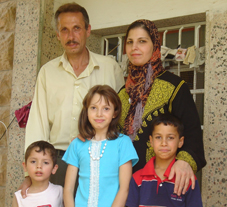Living With the Enemy
這是另一篇「普世同行計劃」(EAPPI;The Ecumenical Accompaniment Programme in Palestine & Israel)志工所寫的文章, 我們希望徵求一名朋友協助翻譯。
EAPPI 是「貴格教派和平與社會見證」(Quaker Peace & Social Witness)與「世界教會協會」(World Council of Churches)所共同籌辦的一個普世運動。EAPPI成立的宗教意義在於團結基督徒和穆斯林,與所有愛好和平的不同教派的人合為一個民族,化解分歧,以求和解。其在巴勒斯坦與以色列所做的工作與「國際團結運動組織」甚為類似,主要是陪伴巴勒斯坦人,與他們共同生活,以阻止或降低以色列士兵對巴人的騷擾與人權侵害。此外EAPPI志工也見證人權狀況,組織和平與非武力運動,以及將巴勒斯坦狀況傳至國際社會。EAPPI每月出版一期通訊,刊載著志工的生活紀錄與報告;志工返回後也會巡迴至各教會或團體演講,將巴以狀況讓更多人知道。
巴勒網過去所翻譯之EAPPI志工報告請見:
這像一首鄉村田園詩嗎?
監獄探訪記
算盤撥盡: 巴勒斯坦的經濟現況
————————————————–
文章出處:http://www.quaker.org.uk/Templates/Internal.asp?NodeID=94151
Hashem Al-Azzeh, his wife Nisreen, daughter Raghad (aged 9), and son Younes (aged 4) live in a big stone house with fantastic views out over the old city of Hebron in the West Bank. Their neighbours are Hashem’s brother and cousin. The Cordoba school where EAs escort pupils in order to protect them from attack by hard line Israeli settlers, is just a short walk from the house. The EAPPI team in Hebron are frequent visitors to Hashem’s house, which has begun to feel to us like a second home.

In many respects the Al-Azzeh’s home would be an ideal place to live and bring up a family except for the fact that, perched above their house, just a stone’s throw away, are a row of houses occupied by Israeli settlers. Stones, rubbish and even bottles of urine have been thrown towards the Al-Azzeh house from the settlers’ houses. The leaves of the trees at the back of Hashem’s house help to hide the family who tip-toe around when they step outside and speak in hushed voices, peering nervously up at the settlers’ houses unsure of when the next stone or bottle will be hurled at them. Hashem tells me that settlers have actually come into his property and they have threatened to ‘rape his wife and kill him and his children’. They have also damaged the olive trees in his garden, punched a friend of his who was helping him harvest olives (captured on camera but no prosecution was made), and they have spray-painted the star of David on the door leading to his brother’s house.
This treatment comes from one of the most violent and extreme factions of the Israeli settler movement. Hashem’s neighbours regard all Palestinians as ‘terrorists’ and all ‘internationals’, like the Ecumenical Accompaniers, as ‘Nazis’. Hashem’s closest neighbour is settler Baruch Marzel, a former spokesman for the now-outlawed extremist Kach movement, which is regarded as a terrorist organisation by both the US and Israel and it has been declared a racist organisation by the Israeli supreme court for advocating the forced expulsion of Palestinians.
The settlers in Hebron are nonetheless extremely well-funded and supported by Jewish groups from many parts of the world. They bring in bus-loads of tourists each week with smiling settler guides presenting ‘their’ version of history. You will not hear them say that their settlements are illegal under international law, nor that, according to most opinion polls, around 65% of Israelis think that settlements should be disbanded. And of course they will not take you to see offensive graffiti such as ‘Gas the Arabs’ or the inscription on the grave of Baruch Goldstein, the Jewish-American doctor who went in to the Ibrahimi mosque in 1994, killing 29 Palestinians and injuring over a hundred, while they were praying. The words, just for the record, say:
“Here lies the saint, Dr. Baruch Kappel Goldstein, blessed be the memory of the righteous and holy man, may the Lord avenge his blood, who devoted his soul to the Jews, Jewish religion and Jewish land. His hands are innocent and his heart is pure. He was killed as a martyr of God on the 14th of Adar, Purim, in the year 5754 (1994).”
It is important to bear in mind that Hebron is a town of over 130,000 Palestinians. There are just 400 Israeli settlers in the middle of this town, and yet it is these settlers who rule the roost. The Israeli government has stationed some 2000 soldiers in the city in order to protect these settlers and this happens at the expense of the rights of the Palestinian residents – again in contravention of international humanitarian law, which requires an occupying power to protect all people in an occupied territory.
Last year Hashem’s 10 year old nephew Yusef had stones forced into his mouth by one of the settler women, severely damaging his teeth. Neither this nor any of the acts of aggression experienced by Hashem or any of his neighbours has ever resulted in any prosecution of the settlers. There is even video footage of attacks perpetrated by the settlers but in Hebron impunity reigns supreme. Israeli soldiers and settlers are frequently seen chatting and laughing together, the settlers often give the soldiers rides in their cars, and, against Israeli law, there is even a group of settlers living inside the Israeli army base on Shuhada Street, a street which Palestinians are prohibited from walking on.
The treatment of the Palestinian population by Israeli soldiers and settlers has been so degrading and unjust that a few years ago a group of soldiers who had served in Hebron decided to speak out. This resulted in the formation of an organisation called ‘Breaking the Silence’ in June 2004. They published and filmed soldiers’ testimonies of human rights abuses they themselves had perpetrated or had seen other soldiers perpetrate and presented these at an exhibition, which took the Israeli public by storm. They now bring groups to Hebron (comprised of both Israelis and internationals) in order to show them what the situation is like for Hebron’s Palestinian residents. They, along with EAPPI’s delegations, are regular visitors to Hashem’s house.[1]
Hashem displays an amazing resilience and lack of bitterness when recounting his experiences. He greets the Israeli ex-combatants from Breaking the Silence with a kiss on each cheek. He is against terrorism and violence – whether from Palestinians or Israelis. He speaks steadfastly of his determination to stay in his home, on his land – despite all the threats and harassment and even the offer, from a settler, of ‘$10 millions and a visa to the USA’. He says: ‘We welcome people of any religion to come and visit the religious sites in Hebron, they can even live here under the Palestinian Authority, but not as occupiers’.
Hashem has repeated the same story and patiently answered the same questions hundreds of times. He receives no money for doing this and indeed the countless cups of tea his wife has made means it is they who are out of pocket. And yet he believes that the people who come to his house will help in some way. All that has to happen is for his story to reach the right ears and then the situation will change. Depressingly, the evidence up until now points to the contrary – Israel has not implemented United Nations’ Security Council resolutions calling for its withdrawal from territories occupied in the 1967 war. Not only that, but settlement construction actually increased after the signing of the Oslo Accords between Israel and the Palestinian Liberation Organisation in 1993.
[1] To find out more about Breaking the Silence, visit their website: http://www.breakingthesilence.org.il/ (English) where you will also find the former soldiers’ testimonies.

